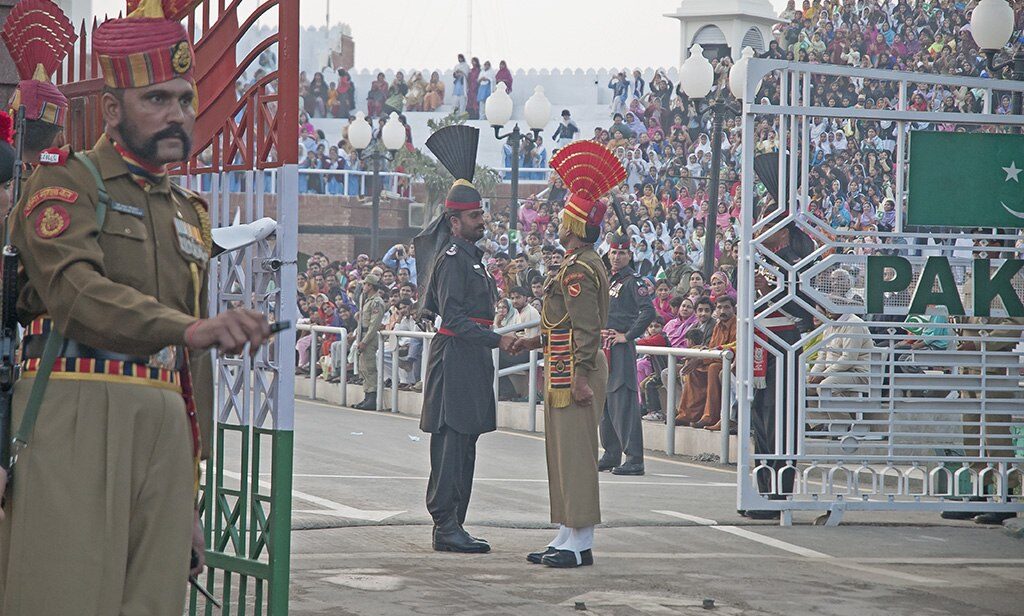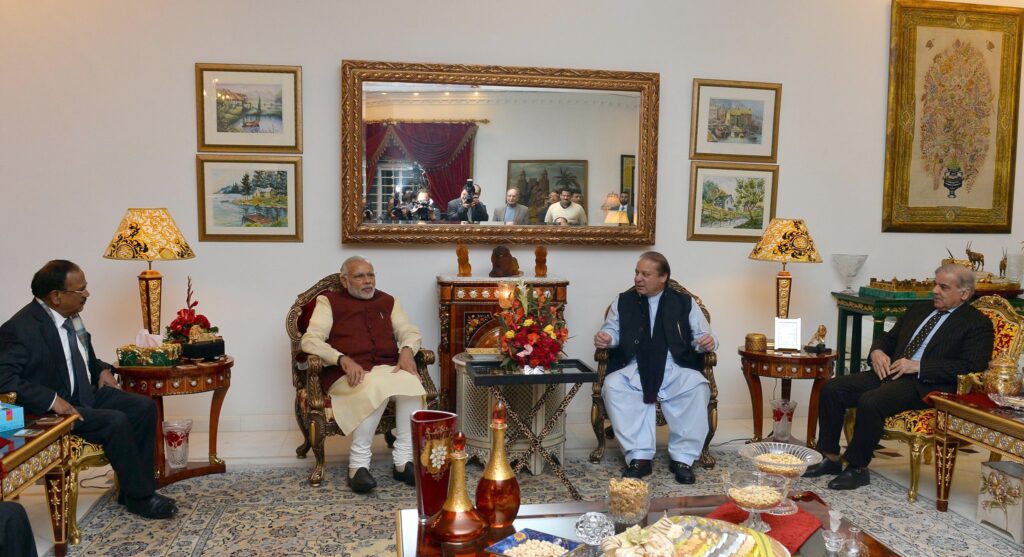
In the past month, Pakistan has experienced considerable tumult in its domestic politics as former Prime Minister Imran Khan was removed from office through a vote of no-confidence. India is reportedly watching Shehbaz Sharif’s assumption of power as the new prime minister with “cautious optimism” and as a potential “diplomatic opening.” Some analysts also expect an impending move towards normalization of ties.
Over at least the past two years, Pakistan has been making various moves that indicate the country’s institutions have collectively decided to pursue a working-level relationship with India and avoid needless hostility. This aim is expected to outlast personnel changes in the civilian and security domains due to the introduction of Pakistan’s first-ever National Security Policy (2022-2026), which sets a direction for Pakistan to pursue trade and interconnectivity in interstate relations. This is broadly the direction and motivation that undergird signs of the country extending an olive branch to India.
Pakistan’s Geoeconomic Pivot
Pakistan’s geoeconomics-driven foreign policy is a function of the collective wisdom of the country’s civilian and military institutions, think tanks, and universities, whose formulation began in 2014. Pakistan has realized that a security-centered approach to dealing with its national security challenges has taken a heavy toll on its economy and defense resource allocation. Additionally, most Western countries primarily dealt with Pakistan for counterterrorism purposes. With a geoeconomic lens, Pakistan wants to encourage foreign governments to engage through trade and economic integration.
For instance, Pakistan looks to expand the China-Pakistan Economic Corridor to include Afghanistan as a “bridge for regional connectivity” to Central Asian countries. To realize this policy without reservation, Pakistan wishes to add east-west connectivity in addition to the North-South corridor. Continued hostility with India could hamper these goals.
Islamabad has made several goodwill gestures toward New Delhi in recent years. These actions do not necessarily signify an appetite in Pakistan for a full-fledged resumption of trade and cultural ties or even complete normalization, given the current political environment in India and the centrality of the Kashmir issue for Pakistan. Instead, the gestures only reflect Islamabad’s intention to resume a working-level relationship with New Delhi.
Pakistan’s Olive Branches to India
An early indication of Pakistan’s policy shift was its choice not to intensify the temperature on its eastern border during the 2020 Sino-Indian military standoff. The height of the COVID-19 pandemic could also have influenced the decision to avoid entangling in a seemingly unnecessary conflict. In this vein, in February 2021, Pakistan and India calmed tensions along the Line of Control (LoC) by reactivating the 2003 LoC ceasefire agreement. It remains the most successful confidence-building measure that both countries engage in today.
Taken together, these are encouraging signs of the potential stability and resumption of bilateral dialogue. However, much will also depend on India’s reciprocal actions. Third parties are also likely to be instrumental in stabilizing or destabilizing India-Pakistan ties.
In November 2021, Pakistan granted India permission to transport wheat and essential pharmaceutical supplies to Afghanistan for “exceptional” humanitarian purposes and has extended that provision for two more months. This significant move could encapsulate the first tangible demonstration of east-west connectivity.
These positive developments could have been derailed by India’s BrahMos missile crash on Pakistani territory in March 2022. Instead, Islamabad decided to dial down the rhetoric around the incident and adopt military restraint. Sensationalism could have generated intense public pressure to retaliate, and a rushed military response could have led to a nuclear catastrophe in South Asia.
Pakistani courts have convicted Hafiz Saeed and other leaders of the Jamatud Dawa (JuD), a UN-proscribed terrorist organization, on terror financing charges. This development demonstrates a break with the past and shows steady political commitment by Pakistan to curb terrorist financing and proscribe the culprit individuals. It would be easy to discount these convictions as proceeding from the duress of the Financial Action Task Force. But if these steps are factored in as part of a series of steps by Pakistan in reducing the tension with India and renouncing the security-centered approach, the needle of the bilateral cooperation could move. In light of this new vision, it is likely that Pakistan’s counter-financing terrorism efforts would be sustained.
While Kashmir remains the most salient issue and a potential flashpoint, Islamabad’s senior civilian and military authorities have reportedly mooted General Pervez Musharraf’s four-point formula: the drawdown of forces, self-governance, no changes in the existing borders, and a joint-supervision mechanism between India and Pakistan.
Taken together, these are encouraging signs of the potential stability and resumption of bilateral dialogue. However, much will also depend on India’s reciprocal actions. Third parties are also likely to be instrumental in stabilizing or destabilizing India-Pakistan ties.
India’s stance and policy recommendations
India has for years maintained the rigid position that it would hold no talks with Pakistan, until the issue of cross-border terrorism is resolved. The gestures above and the lowest amount of cross-LOC infiltrations since 2018 may address this position. Meanwhile, Pakistan should make it impossible for a terrorist to use its soil for cross-border terrorism. Ideally, though far-fetched, both countries could share intelligence on the activities of terrorists in Afghanistan. In a similar vein, India would do well to address the local frustration and disenfranchisement of the Kashmiris and avoid hard-handedness against them—issues that fuel local insurgency, invite censure from foreign governments, and help terrorists to recruit people for violence against the Indian security forces. It would also suit India’s regional interests to reciprocate Pakistan’s actions in order to promote peace along bordering regions and channel more resources toward addressing common domestic economic, security, and environmental challenges.
It would also suit India’s regional interests to reciprocate Pakistan’s actions in order to promote peace along bordering regions and channel more resources toward addressing common domestic economic, security, and environmental challenges.
One confidence building measure could be taking steps towards addressing misinformation and disinformation campaigns that might thwart the warming of ties. During the Sino-Indian standoff in 2020, a number of Indian media outlets detailed an unverified “intelligence report” that Pakistan was mobilizing troops in Gilgit Baltistan to match Chinese deployments on the LAC and warning of a joint China-Pakistan conspiracy—a report that Pakistan categorically refuted. To improve high-level dialogue, both countries could formally agree not to spread disinformation or share misinformation about military deployments unless verified—and in case of prevalence of such information on social or electronic media, both countries should deny those reports.
In the event of a militant attack or another crisis trigger, India should prioritize diplomacy over military actions to help safeguard against unintended provocation leading to escalation. For instance, before launching the Balakot airstrikes in 2019, Indian leaders could have shared with Pakistan the evidence of the involvement of Pakistan-based individuals, and if proven, pressured Islamabad to prosecute those militants. Such crises require both countries to have an active and swift use of the reliable and direct communication (hotline) at various levels. The absence of an effective use of the hotline was glaringly evident in the recent missile crisis. When the BrahMos missile was fired in March 2022, India did not inform Pakistan immediately (it did that only two days later) and this raised suspicions about intentionality behind the launch.
To add momentum to Pakistan’s provision of a land-based transit order to facilitate moving humanitarian goods between India and Afghanistan, the two countries could begin trading additional goods, such as cotton, whose harvests fluctuate season-by-season, and potentially expand even further with time, as Pakistan could import wheat from India. As a further confidence-boosting measure, India could retract its objection to Pakistan’s hosting of the South Asian Association for Regional Cooperation summit. These low-hanging fruits would provide a valuable foundation for the two countries to discuss longstanding issues.

Third-Party Roles
The United States and China are the most strategically engaged external powers in South Asia. Their role in crisis management and economic integration in particular is likely to be instrumental in shaping each country’s course of action in times of tension as well as prospects for economic integration in the region.
Crises have been a repeated cause of halting India-Pakistan talks and how the United States and China respond in the event of a future crisis is likely to have implications for the actions of both countries. The appearance of taking sides in times of tensions—such as Washington’s recent deference to New Delhi’s official statement after the BrahMos launch contrasted with Beijing’s encouragement to improve information sharing bilaterally—could increase hostility. During the 2019 Pulwama-Balakot crisis, former U.S. officials gave statements that emboldened India to conduct airstrikes against Pakistan, enabling dangerous kinetic escalation. Beijing’s public statements suggested a more measured and balanced stance during the crises—criticizing India for violating Pakistan’s territory while also censuring cross-border militancy—thereby satifying both parties. Some former American officials have warned against U.S. statements in a future crisis that appear to justify escalation.
How each country engages in economic projects—particularly ones focused on connectivity, also has the potential to shape how trade and integration in the region develops. The U.S. Indo-Pacific Economic Framework (IPEF) is a work-in-progress and has been criticized for being unauthoritative and non-inclusive. Of concern to Pakistan is the U.S. Indo-Pacific strategy identifying India as a net security provider and supporting its regional leadership, but demonstrably excluding Pakistan from the regional economic plan. Conversely, Beijing has an extensive set of economic projects in Pakistan under the China-Pakistan Economic Corridor and has courted India for the Belt and Road Initiative (BRI). Although the BRI has been criticized as a means of projecting Chinese influence, and its lack of transparency and lending issues, for many countries in the region the infrastructure projects provide a path for connection in “one of the least integrated” areas of the world.
Going forward, it is essential that the United States and China keep their geopolitical rivalry at bay when dealing with India-Pakistan issues and avoid partisan positions. Their engagement in South Asia should drive de-escalation, and potentially look towards increasing interconnectivity and areas of global interest such as non-traditional security threats or climate change.
***
Image 1: Koshy Koshy via Wikimedia Commons


